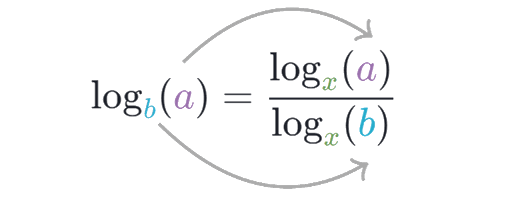LOGARITHM
Subscribe to our ▶️ YouTube channel 🔴 for the latest videos, updates, and tips.
Logarithm of a number to a given base is the index or the power to which the base must be raised to produce the number. That is, to make it equal to the given number.
Let us consider the three quantities, sat a, x and n and they can be related as follows.
If ax = n, where n > 0, a > 0 and a ≠ 1, then x is said to be the logarithm of the number n to the base 'a', symbolically it can be expressed as follows.
logan = x
Here, 'n' is called argument.

Fundamental Laws of Logarithm
Law 1 :
Logarithm of product of two numbers is equal to the sum of the logarithms of the numbers to the same base.
logamn = logam + logan
Law 2 :
Logarithm of the quotient of two numbers is equal to the difference of their logarithms to the same base.
loga(m/n) = logam - logan
Law 3 :
Logarithm of a number raised to a power is equal to the power multiplied by the logarithm of the number to the same base.
logamn = nlogam

Relationship between Exponents and Logarithms
Example 1 :
If logam = x, then
m = ax
Example 2 :
If k = xy, then
logxk = y

Multiplication of Logarithms
Multiplication of two or more logarithms can be simplified, if one of the following two conditions is met.
Condition (i) :
The argument of the first logarithm and the base of the second logarithm must be same.
Condition (ii) :
The base of the first logarithm and the argument of the second logarithm must be same.
Let us see how the multiplication of two logarithms can be simplified in the following examples.
Example 1 :
Simplify : logab ⋅ logbc
In the above two logarithms, the argument of the first logarithm and the base of the second logarithm are same.
So, we can simplify the multiplication of above two logarithms by removing the part circled in red color.

Example 2 :
Simplify : logxy ⋅ logzx
In the above two logarithms, the base of the first logarithm and the argument of the second logarithm are same.
So, we can simplify the multiplication of above two logarithms by removing the part marked in red color.


Change of Base
If the logarithm of a number to any base is given, then the logarithm of the same number to any other base can be determined from the following relation.
logba = logxa ⋅ logbx
logba = logxa / logxb
More clearly,

In the above example, the base of the given logarithm 'b' is changed to 'x'.
In this way, we can change the base of the given logarithm to any other base.

Inverse Properties of Logarithms

Some other Properties of Logarithms
Property 1 :
If you switch a logarithm from numerator to denominator or denominator to numerator, we have to interchange the argument and base.
Examples :
logab = 1/logba
5/(2logxy) = 5logyx/2
Property 2 :
Logarithm of any number to the same base is equal to 1.
Examples :
logxx = 1
log33 = 1
The above property will not work, if both the base and argument are 1.
log11 ≠ 1
The reason for the above result is explained in the next property.
Property 3 :
Logarithm of 1 to any base is equal to 0.
Examples :
logx1 = 0
log31 = 0

Notes
1. If the base is not given in a logarithm, it can be taken as 10.
log 10 = log10 10 = 1
log 1 = log10 1 = 0
2. Logarithm using base 10 is called Common logarithm and logarithm using base 'e' is called Natural logarithm.
Here, e ≈ 2.718 called exponential number.
Solved Problems
Problem 1 :
Find the logarithm of 125 to the base 5.
Solution :
Write 125 as a power of 5.
125 = 5 x 5 x 5
= 53
log5125 = log5(5)3
= 3log55
= 3(1)
= 3
Problem 2 :
Find the logarithm 1728 to the base 2√3.
Solution :
Write 1728 as a power of 2√3.
1728 = 2 x 2 x 2 x 2 x 2 x 2 x 3 x 3 x 3
1728 = 26 x 33
1728 = 26 x [(√3)2]3
1728 = 26 x (√3)6
1728 = (2√3)6
log2√3(1728) = log2√3(2√3)6
Using the power rule of logarithms,
= 6log2√3(2√3)
= 6(1)
= 6
Problem 3 :
Find the logarithm of 0.001 to the base 0.1.
Solution :
log0.10.001 = log0.1(0.1)3
= 3log0.10.1
= 3(1)
= 3
Problem 4 :
Find the logarithm 1/64 to the base 4.
Solution :
log4(1/64) = log41 - log464
= 0 - log4(4)3
= -3log44
= -3(1)
= -3
Problem 5 :
Find the logarithm of 0.3333...... to the base 3.
Solution :
log3(0.3333......) = log3(1/3)
= log31 - log33
= 0 - 1
= -1
Problem 6 :
If logy(√2) = 1/4, find the value of y.
Write the equation in exponential form.
√2 = y1/4
Raise to the power 4 on both sides.
(√2)4 = (y1/4)4
(21/2)4 = y
22 = y
4 = y
Problem 7 :
Simplify :
(1/2)log1025 - 2log103 + log1018
Solution :
= (1/2)log1025 - 2log103 + log1018
Using power rule of logarithms,
= log10251/2 - log1032 + log1018
= log10(52)1/2 - log1032 + log1018
= log105 - log109 + log1018
= log105 + log1018 - log109
Using the product rule of logarithms,
= log10(5 x 18) - log109
= log1090 - log109
Using the quotient rule of logarithms,
= log10(90/9)
= log1010
= 1
Problem 8 :
What is the value of log1 1?
A) log1 1 = 1
B) log1 1 = 0
C) log1 1 = Not Defined
Solution :

Video Lessons
Subscribe to our ▶️ YouTube channel 🔴 for the latest videos, updates, and tips.
Kindly mail your feedback to v4formath@gmail.com
We always appreciate your feedback.
About Us | Contact Us | Privacy Policy
©All rights reserved. onlinemath4all.com

Recent Articles
-
10 Hard SAT Math Questions (Part - 38)
Dec 29, 25 04:21 AM
10 Hard SAT Math Questions (Part - 38) -
10 Hard SAT Math Questions (Part - 39)
Dec 28, 25 11:20 PM
10 Hard SAT Math Questions (Part - 39) -
10 Hard SAT Math Questions (Part - 41)
Dec 28, 25 06:05 PM
10 Hard SAT Math Questions (Part - 41)

